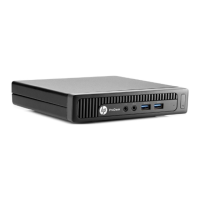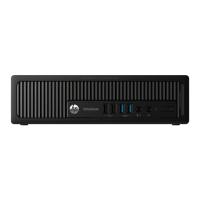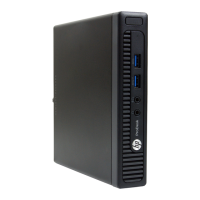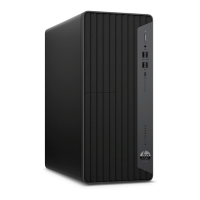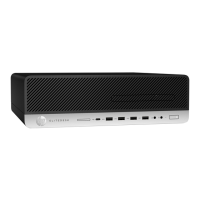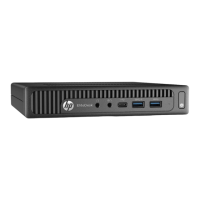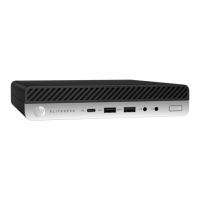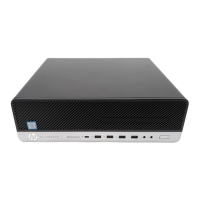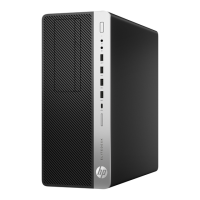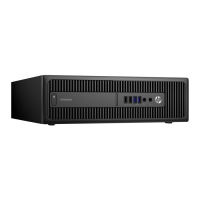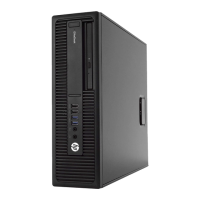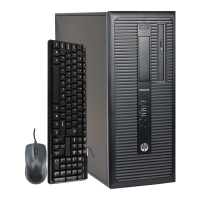
Do you have a question about the HP EliteDesk 800 G1 Tower and is the answer not in the manual?
| Tcase | 72.72 °C |
|---|---|
| Bus type | DMI |
| Stepping | C0 |
| Processor cache | 8 MB |
| Processor cores | 4 |
| Processor model | i7-4790 |
| System bus rate | 5 GT/s |
| Processor family | Intel® Core™ i7 |
| Processor series | Intel Core i7-4700 Desktop series |
| Processor socket | LGA 1150 (Socket H3) |
| Processor threads | 8 |
| Processor codename | Haswell |
| Number of QPI links | 0 |
| Processor frequency | 3.6 GHz |
| Processor cache type | Smart Cache |
| Processor lithography | 22 nm |
| Processor manufacturer | Intel |
| Processor front side bus | - MHz |
| PCI Express slots version | 3.0 |
| Processor boost frequency | 4 GHz |
| Processor operating modes | 32-bit, 64-bit |
| ECC supported by processor | No |
| PCI Express configurations | 1x16, 2x8, 1x8+2x4 |
| Thermal Design Power (TDP) | 84 W |
| Number of processors installed | 1 |
| Maximum number of PCI Express lanes | 16 |
| Memory types supported by processor | DDR3-SDRAM |
| Memory clock speeds supported by processor | 1333, 1600 MHz |
| Memory bandwidth supported by processor (max) | 25.6 GB/s |
| Maximum internal memory supported by processor | 32 GB |
| Memory slots | 4x DIMM |
| Internal memory | 4 GB |
| Memory channels | Dual-channel |
| Memory clock speed | 1600 MHz |
| Memory layout (slots x size) | 1 x 4 GB |
| HDD speed | 7200 RPM |
| HDD interface | SATA |
| Storage media | HDD |
| Optical drive type | DVD-ROM |
| Card reader integrated | - |
| Total storage capacity | 500 GB |
| Intel segment tagging | Enterprise |
| Intel® Virtualization Technology (Intel® VT) | VT-d, VT-x |
| On-board graphics card | Yes |
| On-board graphics card ID | 0x412 |
| Discrete graphics card model | Not available |
| On-board graphics card model | Intel® HD Graphics 4600 |
| On-board graphics card family | Intel® HD Graphics |
| Maximum on-board graphics card memory | 1.024 GB |
| On-board graphics card base frequency | 350 MHz |
| On-board graphics card DirectX version | 11.1 |
| On-board graphics card dynamic frequency (max) | 1200 MHz |
| Number of displays supported (on-board graphics) | 3 |
| Recovery operating system | Windows 8.1 Pro |
| Operating system installed | Windows 7 Professional |
| Operating system architecture | 64-bit |
| Cabling technology | 10/100/1000Base-T(X) |
| Ethernet LAN data rates | 10, 100, 1000 Mbit/s |
| USB 2.0 ports quantity | 6 |
| Chassis type | Micro Tower |
| Product color | Black |
| Country of origin | China |
| Product type | PC |
| Motherboard chipset | Intel® Q87 |
| Scalability | 1S |
| Processor code | SR1QF |
| Processor ARK ID | 80806 |
| Intel TSX-NI version | 0.00 |
| Processor package size | 37.5 x 37.5 mm |
| Supported instruction sets | AVX 2.0, SSE4.1, SSE4.2 |
| Thermal solution specification | PCG 2013D |
| Intel Identity Protection Technology version | 1.00 |
| Power supply | 320 W |
| Operating temperature (T-T) | 10 - 35 °C |
| Operating relative humidity (H-H) | 10 - 90 % |
| Depth | 442 mm |
|---|---|
| Width | 170 mm |
| Height | 399 mm |
| Weight | 9300 g |
Overview of standard features across different computer models.
Lists spare parts for the Tower (TWR) chassis, including major components.
Lists spare parts for the Small Form Factor (SFF) chassis, including major components.
Lists spare parts for the Ultra-slim Desktop (USDT) chassis, including major components.
Explains the risks of static discharge and how to prevent damage to components.
Procedures for removing and replacing the system board and expansion slot daughter card.
Step-by-step guide to removing and replacing the SFF power supply unit.
Initial steps and safety procedures before disassembling the USDT computer.
Information on memory modules (SODIMMs) for USDT, types, and installation.
Detailed instructions for removing and replacing the processor in USDT computers.
Procedures for removing and replacing the system board in USDT computers.
Overview of functions and access methods for the Computer Setup (F10) utility.
Recommended steps to isolate problems before contacting technical support.
Common causes and solutions for general computer problems like lock-ups.
Troubleshooting steps for common display issues like blank screens or fuzzy images.
Solutions for common audio problems like sound cutting out or low volume.
Solutions for common keyboard and mouse issues like unresponsiveness or jerky movement.
Guidance for resolving issues when adding or removing hardware.
Troubleshooting steps for common network connectivity issues.
Solutions for common software issues like installation errors or conflicts.
Troubleshooting steps for common processor issues like overheating or poor performance.
Troubleshooting steps for common Internet connectivity issues.
Lists POST error codes, messages, and recommended actions for troubleshooting.
Steps to reset CMOS to factory defaults, including backing up settings.
Instructions for clearing setup or power-on passwords by resetting a jumper.
Explains the benefits and purpose of using HP PC Hardware Diagnostics.
Step-by-step guide on accessing and launching the UEFI diagnostics tool.
Overview of tools and processes for backing up and recovering data in Windows 8.
Overview of tools and processes for backing up and recovering data in Windows 7.
Explains how to perform a system recovery to restore factory settings.
Steps for performing system recovery when Windows is operational.
Instructions for system recovery using created recovery media.
